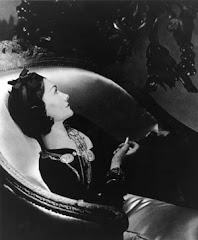scene from In the Loop released Friday which I saw at a press screening today.
Tuesday, 14 April 2009
Not the West Wing
Posted by
Linda Grant
at
21:41
7
comments
![]()
![]()
![]()
![]()
Labels: video
Trying on Marilyn's clothes

What size was Marilyn Monroe? A Times journalist tries on her clothes.
As I tentatively tried to coerce my way into the Some Like It Hot dress, Valerie Nelson, the woman charged with caring for the pieces in the Jersey exhibition, talked me through Monroe’s body shape. Monroe was 5ft 5in (I’m an inch shorter); just over eight stone (I’m ¾ of a stone heavier); she had a respectable BMI of 21 (don’t ask). She had an incredibly narrow back and rib cage but big boobs, so if she were to pop into Rigby & Peller for a bra fitting today she would probably be a 30E.
She didn’t have a long body, and although her legs were a lovely shape (beautiful bony ankles and knees) they weren’t particularly long. She had a very short rise (the distance from waist to crotch), but what made her body so extraordinary was the 13-inch difference between her breast and hip measurements and her waist. In her younger years her vital statistics would have come in at 36 23 35, and although her weight fluctuated throughout her career, she always maintained that out-of-this-world body ratio. A real life Jessica Rabbit.
Nelson tells me that they had to get a special mould made for the corset and swimwear dummies in the exhibition because Monroe was such an extreme hourglass shape that no off-the-peg dummies existed in those measurements. The Some Like It Hot dress just about zips up on me – which is pretty mortifying, considering I had always thought of her Sugar phase as a gloriously plump one.
Posted by
Linda Grant
at
07:50
112
comments
![]()
![]()
![]()
![]()
1001 reasons not to buy cheap clothes

(if you can afford better)
The Guardian reports that clothes from Primark don't sell in charity shops:
' . . . I'm surprised that so many clean items in almost pristine condition aren't sellable - anything from Primark, for instance, or one of the supermarkets, and especially children's clothes. "They're so cheap to begin with that we can't sell them," says Sue. They would take up valuable space in the small shop. Instead these clothes go in the "rag" pile - they are bought by "the rag man", who comes every week to collect the bags and pays around £100 for a load: the good clothes are sent to developing countries, the unusable ones are recycled'
Considering some of these clothes were only worn once or twice in the first place they only good thing that may ever happen in their short lives is that they're recycled to make something a bit better
Posted by
Linda Grant
at
07:34
182
comments
![]()
![]()
![]()
![]()
Labels: Ethics
